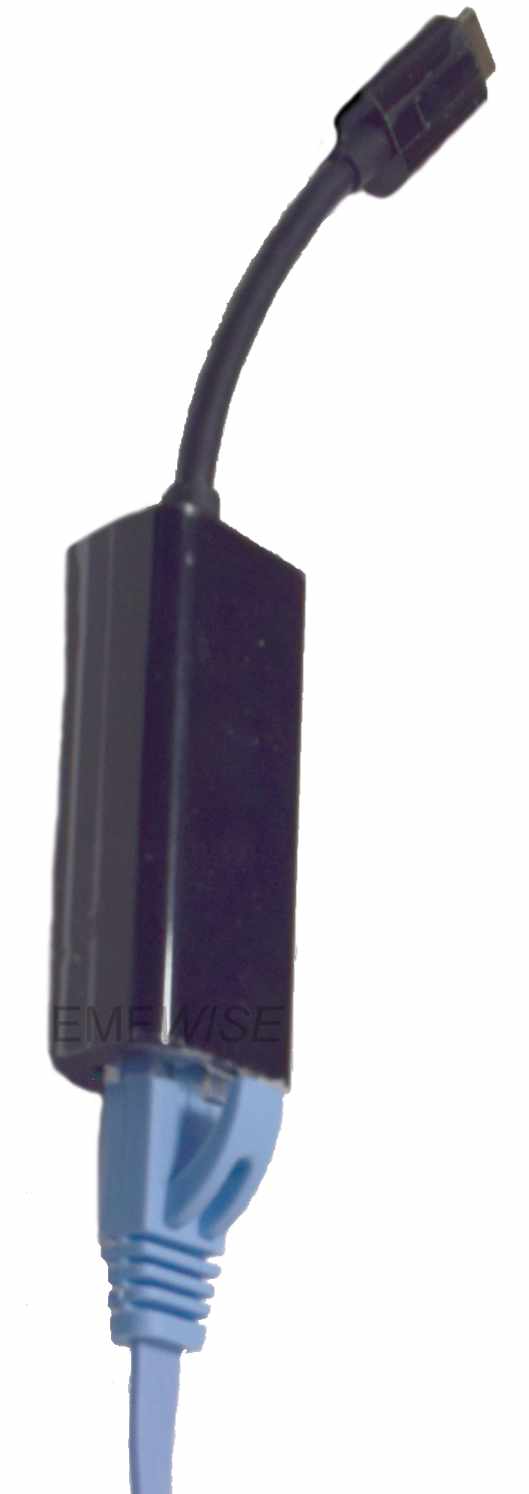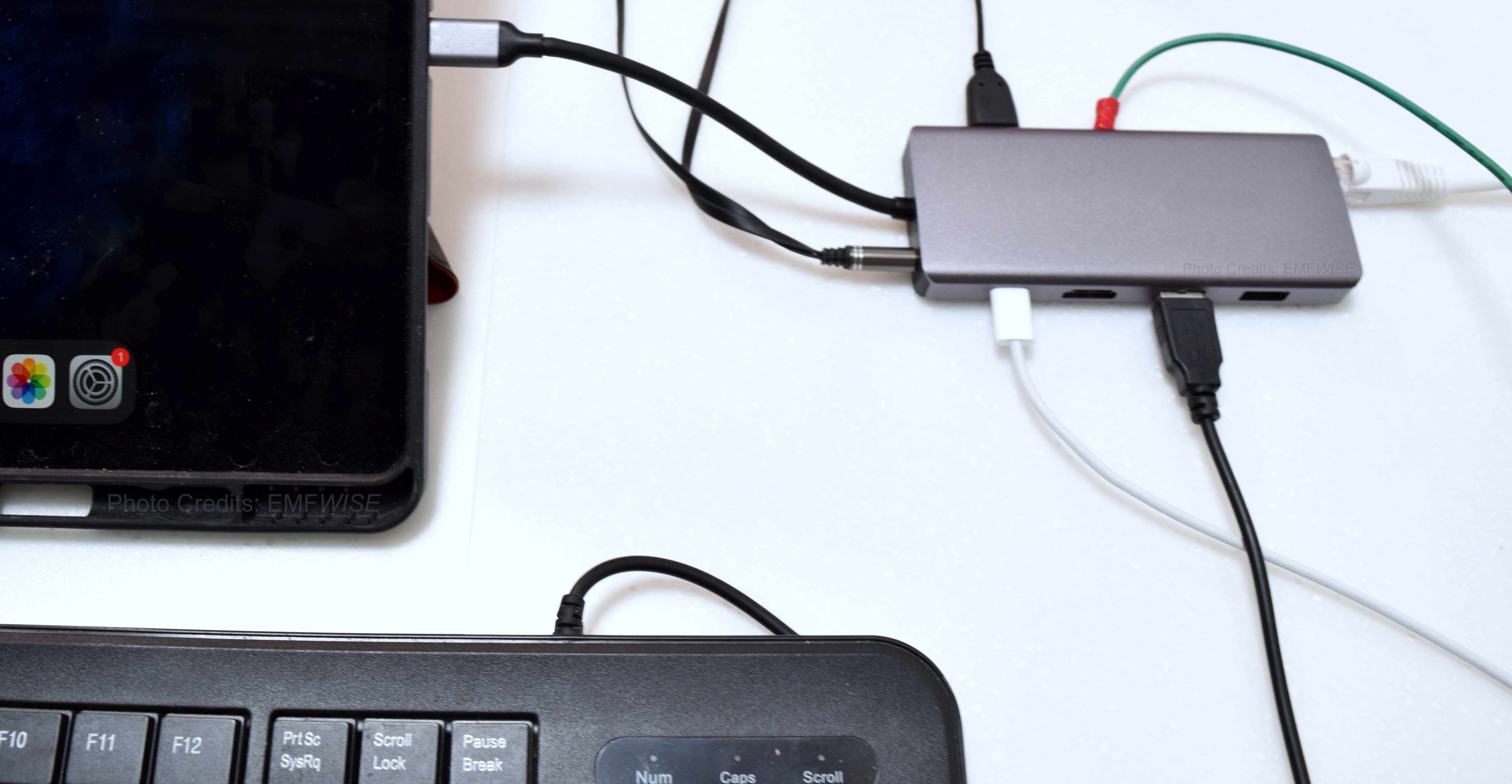How to Hardwire a Smartphone, Tablet, or Laptop for Internet Access
Concerned about hours of constant wireless exposure every day from online meetings? Fortunately, many smartphones and tablets can now be wired to access the Internet via Ethernet cable even though they do not come with an Ethernet interface. This is possible through an appropriate Ethernet adapter or a multiport hub containing an Ethernet interface. Even if your home is not wired for Ethernet, there is also a quick and easy way to set up home internet for Ethernet using existing electrical cabling and some powerline adapters. Changing to a wired setup may protect against the numerous effects, which have been reported from wireless exposure, including oxidative stress, reduced levels of glutathione, an important antioxidant for a healthy immune system, depression, sleep disturbances, and so on. (See Bioinitative Research Summaries 2020 and Pall 2016).
The following instructions provide info on how to connect your device to the Internet via Ethernet cable. These instructions assume that you already have access to an Ethernet port that is connected to the router used for internet access. If your home is not wired for internet access via Ethernet cables, and you wish to access the internet from a room far from the router, see How to Hardware Your Home's Internet via Internet over Powerline.
Using an Ethernet Adapter to Hardwire Your Smartphone, Tablet, or Laptop

USB-C to Ethernet Adapter
Photo Credits: EMFWise
If a smartphone, tablet, or laptop contains a USB-C, lightning, micro-USB, or USB port, it may be possible to obtain an Ethernet adapter to connect it to an Ethernet cable which can then be connected to the router for internet access. Note that not all mobile devices have operating systems that support internet access via Ethernet adapter. However, many Apple devices, like the iPhone and iPad, may support either a USB-C to Ethernet adapter or Lightning to Ethernet Adapter.
If your device contains a USB-C port or Lightning port but no Ethernet port, it can still be connected to an Ethernet cable via an adapter. The following photo is an example of a USB-C adapter connected to an Ethernet cable.
To search for an Ethernet adapter, you may use the following keywords:
- If your device has a Lightning interface, search for a “Lightning to Ethernet Adapter” or
- If your device has a USB Type-C (USB-C) interface, search for a "USB Type-C (USB-C) to Ethernet Adapter.”
- If your device has a micro-USB interface, search for a “Micro-USB to Ethernet Adapter.”
- If your device has a USB interface, search for a “USB to Ethernet Adapter.”
Turning off wireless settings
Even though the device is wired, it may continue to use wireless technology unless you disable the wireless settings. Once the wired connection is working, turn off the wireless settings for Wi-Fi, Mobile Data/Cellular, 5G, and Bluetooth on your device and verify that the internet connection still works.
Upgrading to a Multi-Function, Multiport Hub with Ethernet Interface
One limitation of the above solution is that your smartphone or tablet may only have one USB-C or Lightning interface. For example, the iPad Pro pictured below only has one USB-C interface, so it cannot be connected to 2 separate cables.

iPad Pro Connected to Multiport Hub with Ethernet / Photo Credits: EMFWise
If your device has only one interface, it cannot support a separate charging cable and Ethernet Adapter. Instead, you can obtain a Multi-function, Multiport Hub that supports both your device's USB-C or Lightning interface for charging AND an Ethernet interface. In this way, you can simultaneously charge your device and connect it via Ethernet cable to the Internet.
Checklist
1. Verify that ithe Multiport Hub you obtain supports the interface that your device uses, whether USB-C or Lightning. For example, some iPad models will require a Lightning interface and others will require a USB-C interface.
2. Furthermore, check that the Multiport Hub you obtain has at minimum a charging interface, an Ethernet interface, and a USB interface (if you want to ground the Hub as described below).
Choosing Features Desired for the Multiport Hub
Multi-function or Multiport Hubs may include a variety of other interfaces in addition to the Ethernet interface, such as the following.
Depending upon your budget, consider whether these additional functions might be needed.

Multiport Hub with Ethernet Interface / Photo Credits: EMFWise
- LAN / RJ45 / Ethernet / Gigabit Ethernet interface to access the internet via Ethernet cable
- Charging interface : Note that even if the charging port is USB-C, the USB-C / PD3.0 may support charging only.
- USB interface to attach a wired USB keyboard, a USB thumb drive, or to power a wired USB speaker
- HDMI interface to project to a monitor via HDMI cable
- VGA interface to project to a monitor via VGA cable
- Audio jack 3.5mm / Headphone jack to attach a headset, microphone, or speaker.
- SD port to insert an SD card containing photos from your camera
- Micro-SD port
Grounding the Multiport Hub
Charging your device while using it to connect to the Internet may result in higher body voltage measurements, unless the system is grounded indirectly via a connected monitor which is grounded by a 3-pronged power cable. One solution is to connect the hub to a monitor to ground the system indirectly. Another solution to reduce the body voltage measurement is to attach a USB grounding cable to the Multiport Hub. An inexpensive USB grounding cable can be obtained from Less EMF. Read more about how to ground a device via the USB port.
Turning off wireless settings
Remember also to turn off wireless settings on your device when it is connected via Ethernet to the Internet. This includes Wi-Fi, Cellular/Mobile Data, 5G, and Bluetooth.
Troubleshooting
Using a multi-functional, multiport hub, the iPad Pro pictured above can be connected to a wired USB keyboard, power cable, USB ground cable, audio cable, and so forth. Some limitations were identified in the support for wired devices.
- Note that certain iPad Pro models may not support a wired USB mouse. Instead, the device may only support a bluetooth mouse, but using one will involve exposure to wireless radiation. To get around this issue, a pen with rubber tip can be obtained to touch the screen of the iPad as shown below.
- Additionally, there may be difficulties with a hub's audio jack not supporting headsets with speakerphones. One workaround might be to use a audio splitter cable and plugging in a separate earphone and microphone.

Pen with Rubber Tip / Photo Credits: EMFWise
For more tips and troubleshooting guidance, check out the thirdparty links below.
Reference
How to Hardwire Your Home's Internet via Internet over Powerline

Preparing your device for Ethernet access is of no use unless you have access to your router's Ethernet port or a separate internet-ready Ethernet port that is connected to the router.
The good news is that there are quick and easy ways to wire one's home for Ethernet
such as Internet over Powerline.
This requires the use of at least two powerline ethernet adapters, one connected to the router by Ethernet cable and one connected to your device by Ethernet cable.
Read More

